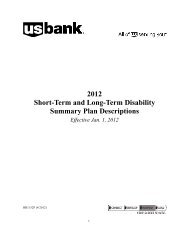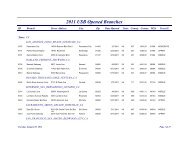The eligibility and enrollment rules for the U
The eligibility and enrollment rules for the U
The eligibility and enrollment rules for the U
You also want an ePaper? Increase the reach of your titles
YUMPU automatically turns print PDFs into web optimized ePapers that Google loves.
Retiree Health Care SPD Effective January 1, 2012<br />
In-Network Provider<br />
For <strong>the</strong> Early Retiree Medical option, a provider who has entered into a service agreement with<br />
<strong>the</strong> medical Claims Administrator <strong>for</strong> <strong>the</strong> network associated with your location <strong>and</strong> health care<br />
option. If you receive services from an in-network provider, your expenses are generally covered<br />
at a higher level than if you chose an out-of-network provider <strong>and</strong> you will not be responsible <strong>for</strong><br />
paying <strong>the</strong> difference between <strong>the</strong> billed charge <strong>and</strong> <strong>the</strong> allowed amount. Refer to <strong>the</strong> “Which<br />
Network Providers to Use” section of this SPD <strong>for</strong> more in<strong>for</strong>mation on <strong>the</strong> provider networks.<br />
Lifetime Maximum<br />
<strong>The</strong> cumulative maximum amount payable by <strong>the</strong> Program <strong>for</strong> a particular non-essential covered<br />
medical service or prescription drug incurred by you during your lifetime or by each of your<br />
covered dependents during <strong>the</strong> dependent's lifetime under all U.S. Bank Health Care Plans. <strong>The</strong><br />
maximum does not include amounts that are your responsibility (deductibles, coinsurance,<br />
copayments, penalties <strong>and</strong> o<strong>the</strong>r amounts). Exceeding <strong>the</strong> lifetime maximum does not cause you<br />
or your dependents to be eligible <strong>for</strong> any conversion right provided by <strong>the</strong> program. Refer to <strong>the</strong><br />
“What <strong>the</strong> Options Cover” section in this SPD <strong>for</strong> specific lifetime maximums on certain<br />
services. For lifetime maximums related to prescription drugs, see <strong>the</strong> “Pharmacy” section in this<br />
SPD.<br />
Medical Supply<br />
Supplies prescribed by a physician as medically necessary <strong>for</strong> treatment of an illness or injury.<br />
Examples include casts, splints, trusses, braces or crutches, blood or blood plasma <strong>and</strong><br />
pros<strong>the</strong>tics. Medical supplies are not reusable <strong>and</strong> usually last less than one year.<br />
Medically Necessary<br />
A health care service, treatment or supply furnished by a particular provider is considered<br />
medically necessary if, in <strong>the</strong> judgment of <strong>the</strong> Claims Administrator (or any person or third party<br />
to whom it delegates authority), it is appropriate <strong>for</strong> <strong>and</strong> consistent with <strong>the</strong> diagnosis, care or<br />
treatment of <strong>the</strong> illness or injury <strong>and</strong>:<br />
• it is in accordance with generally accepted medical st<strong>and</strong>ards <strong>and</strong> good medical practice<br />
(e.g., recognized by <strong>the</strong> American Medical Association) <strong>and</strong> requires <strong>the</strong> technical skills<br />
of a medical, mental health or dental professional;<br />
• it is indicated by <strong>the</strong> health status of <strong>the</strong> patient <strong>and</strong> is as likely to produce a significant<br />
positive outcome, <strong>and</strong> no more likely to produce a negative outcome, as any alternative<br />
service or supply;<br />
• omitting it would adversely affect <strong>the</strong> patient's condition or <strong>the</strong> quality of medical care<br />
rendered;<br />
• it is <strong>the</strong> most appropriate level of service or treatment (<strong>for</strong> example, hospital inpatient<br />
care that could not be provided appropriately on an outpatient basis);<br />
• it is not furnished solely because <strong>the</strong> person is an inpatient, when <strong>the</strong> disease or injury<br />
could safely <strong>and</strong> adequately be diagnosed or treated on an outpatient basis;<br />
• it is not solely <strong>for</strong> <strong>the</strong> convenience of <strong>the</strong> patient or <strong>the</strong> physician, hospital or o<strong>the</strong>r<br />
provider; <strong>and</strong><br />
• it is no more costly than any alternative service or supply that meets <strong>the</strong> above criteria.<br />
Relevant in<strong>for</strong>mation that will be taken into account when determining if a health care service,<br />
treatment or supply is appropriate includes:<br />
• in<strong>for</strong>mation provided about <strong>the</strong> patient's health status;<br />
• guidelines established by <strong>the</strong> BCBS Medical Policy Committee;<br />
147
















